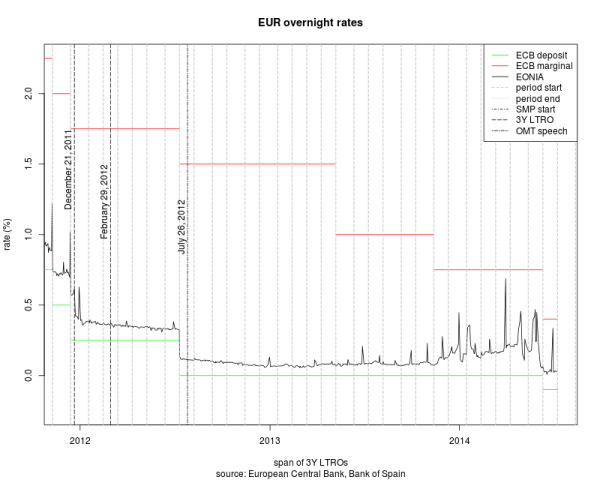Mario Draghi’s “historical measures” (as defined by Bloomberg) are best seen as ways to restore the interbank rate of interest (EONIA) that prevailed throughout 2013, when the interest rate that banks paid each other for lending and borrowing liquidity (aka “reserves”) had stabilized a few basis points above zero.
This rate is the main policy-driven rate that shapes all money market rates. A super-low and stable EONIA had been the outcome of two ECB measures in 2012: the VLTROs and the Deposit Facility rate cut to zero.
Then, in 2014, with Eurozone banks accelerating repayments of VLTRO, bank liquidity has inevitably fallen. This can only be a problem as long as the fragmentation of the banking system persists and some banks prefer to bear the costs of holding excess liquidity rather than lending to banks they don’t trust. In addition, large “autonomus factors” (such as tax payment deadlines in large countries like Italy) and Fed announcements of tapering (relevant to those banks with high dollar exposure) added more instability. In some cases, the rate has steeped up to its natural ceiling (i.e., the rate set by the ECB on marginal lending operations).
The result of the above factors was that EONIA became more volatile and moved north, contrary to the ECB’s monetary policy strategy.
Thus, on June 5, the ECB corrected its operational framework, moving the “corridor of interest rates” down, while adding more “excess liquidity” to the banking system.
The chart, courtesy of @MigeruBlogger (click to enlarge), nicely illustrates how the ECB has found it increasingly difficult to maintain the policy-driven rate near zero, and how the most recent measures seem to have improved ECB’s ability to control EONIA. However, banks may still face tight liquidity conditions in the market for reserves. Notice the interest rate peak at the end of June 2014, a sign that some degree of banking fragmentation is still a factor in the European banking system.
Bottom line: The ECB has been targeting EONIA with varying degree of success. The June 4 measures seem to have helped the ECB to more effectively steer EONIA towards a target somewhere in the range of 0-0.05%.
